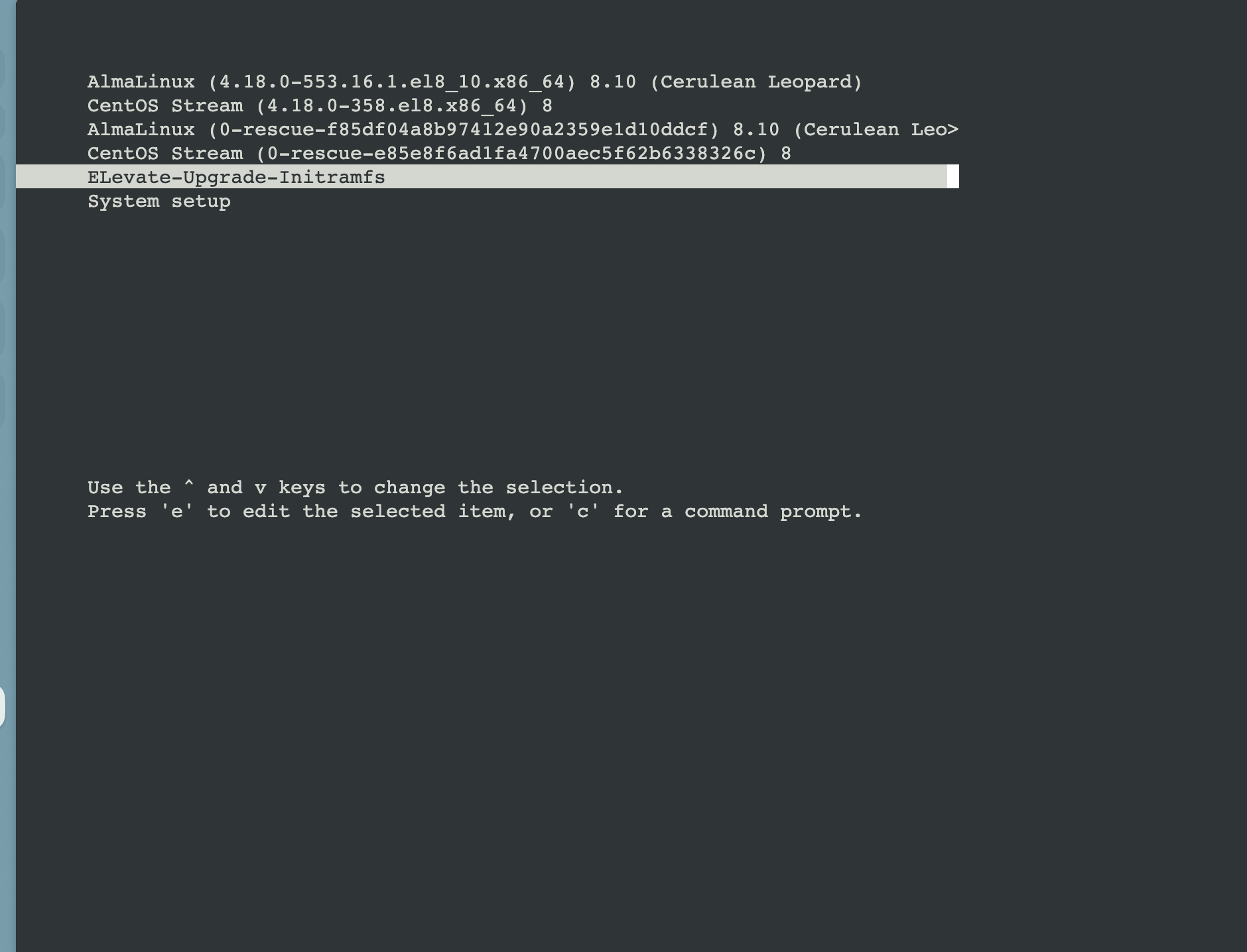OS migrations
Translations
This tutorial is also available in the following languages:
Check the OS release
cat /etc/os-release
cat /etc/redhat-release
CentOS 8 Stream to Almalinux 8
Between 30 min and 1 hour.
Every step has to be run with the root user.
curl -O https://raw.githubusercontent.com/AlmaLinux/almalinux-deploy/master/almalinux-deploy.sh
bash almalinux-deploy.sh
If you have this error:
bash almalinux-deploy.sh
Check root privileges OK
Use '-d or --downgrade' option to allow downgrade from CentOS Stream ERROR
Run this instead:
bash almalinux-deploy.sh -d
Once it's finished you should have this message:
The new EFI boot record for AlmaLinux is added OK
Migration to AlmaLinux is completed
Then reboot:
reboot
Then check the result:
cat /etc/redhat-release
AlmaLinux release 8.10 (Cerulean Leopard)
dnf update -y
dnf upgrade -y
AlmaLinux 8 to AlmaLinux 9
Between 1 hour and 3 hour.
Every step has to be run with the root user.
curl https://repo.almalinux.org/elevate/testing/elevate-testing.repo -o /etc/yum.repos.d/elevate-testing.repo
rpm --import https://repo.almalinux.org/elevate/RPM-GPG-KEY-ELevate
dnf install -y leapp-upgrade leapp-data-almalinux
Run a preupgrade which will check if everything will be ok:
leapp preupgrade
cat /var/log/leapp/leapp-report.txt # check the report
If you find high (inhibitor) issues you'll have to fix it. You'll find a list of the common error here.
Once it's fixed, run the upgrade again:
leapp upgrade
Then you'll have a report like that:
============================================================
REPORT OVERVIEW
============================================================
HIGH and MEDIUM severity reports:
1. Leapp detected loaded kernel drivers which are no longer maintained in RHEL 9.
2. Packages not signed by Red Hat found on the system
Reports summary:
Errors: 0
Inhibitors: 0
HIGH severity reports: 2
MEDIUM severity reports: 0
LOW severity reports: 3
INFO severity reports: 2
Before continuing consult the full report:
A report has been generated at /var/log/leapp/leapp-report.json
A report has been generated at /var/log/leapp/leapp-report.txt
============================================================
END OF REPORT OVERVIEW
============================================================
Open a web/kvm console of your virtual machine in order to access to the grup menu and restart:
reboot
Then, quickly select the ELevate-Upgrade-Initramfs entry:

Then let the upgrade continue on the kvm/web console, the reboot will be automatic.
Once it's finished, open a new SSH connection and check:
cat /etc/redhat-release
AlmaLinux release 9.3 (Shamrock Pampas Cat)
dnf update -y
dnf upgrade -y
Run those commands to fix the ansible pipeline1:
pip install hvac
dnf install snapd -y
And to finish, in the ansible configuration, update the following variables and relaunch a pipeline:
centos_version: 9
docker_legacy_repo_install: false
docker_repo_install: true
You might have to update your ansible role to replace the docker-compose command by docker compose and remove all containers in order to recreate them:
docker ps -a|awk '{system ("docker rm -f "$1)}'
Leapp common errors
Here you'll find a list of the common errors you can encounter during the leapp preupgrade or leapp upgrade commands.
Symbolic links which point to absolute paths
Example of message you'll get:
Risk Factor: high (inhibitor)
Title: Upgrade requires links in root directory to be relative
Summary: After rebooting, parts of the upgrade process can fail if symbolic links in / point to absolute paths.
Please change these links to relative ones.
Remediation: [command] sh -c ln -snf var/lib/snapd/snap /snap
Key: XXXXX
You have to fix it, like that:
cd /
ln -snf var/lib/snapd/snap /snap
Custom network-scripts detected
Example of message you'll get:
Risk Factor: high (inhibitor)
Title: custom network-scripts detected
Summary: RHEL 9 does not support the legacy network-scripts package that was deprecated in RHEL 8. Custom network-scripts have been detected.
Remediation: [hint] Migrate the custom network-scripts to NetworkManager dispatcher scripts manually before the upgrade. Follow instructions in the official documentation.
Key: XXXXX
You have to fix it, like that:
mkdir /opt/network-scripts/
mv /sbin/if*-local /opt/network-scripts/
Create the /etc/NetworkManager/dispatcher.d/20-if-local file with the following content:
#!/bin/bash
test -n "$DEVICE_IFACE" || exit 0
run() {
test -x "$1" || exit 0
"$1" "$DEVICE_IFACE"
}
case "$2" in
"up")
run /opt/network-scripts/ifup-local
;;
"pre-up")
run /opt/network-scripts/ifup-pre-local
;;
"down")
run /opt/network-scripts/ifdown-local
;;
"pre-down")
run /opt/network-scripts/ifdown-pre-local
;;
esac
Set the permissions on the /etc/NetworkManager/dispatcher.d/20-if-local script:
chown root:root /etc/NetworkManager/dispatcher.d/20-if-local
chmod +x /etc/NetworkManager/dispatcher.d/20-if-local
restorecon /etc/NetworkManager/dispatcher.d/20-if-local
If you require pre-up or pre-down events, create a symbolic link in the corresponding dispatcher directory:
ln -s ../20-if-local /etc/NetworkManager/dispatcher.d/pre-up.d/
ln -s ../20-if-local /etc/NetworkManager/dispatcher.d/pre-down.d/
All these instructions are in the official documentation of Redhat.
Not enough disk space
Example of message you'll get:
2024-08-20 09:38:32.570 ERROR PID: 43069 leapp.workflow.Download.dnf_package_download: Cannot calculate, check, test, or perform the upgrade transaction.
============================================================
ERRORS
============================================================
2024-08-20 09:38:33.171673 [ERROR] Actor: dnf_package_download
Message: There is not enough space on some file systems to perform the upgrade transaction.
Summary:
Hint: Increase the free space on listed filesystems. Presented values are required minimum calculated by RPM and it is suggested to provide reasonably more free space (e.g. when 200 MB is missing on /usr, add 1200MB or more).
Disk requirements: At least 1120MB more space needed on the / filesystem.
You have to clean a little bit. Most of the time, cleaning docker unused volumes or layers is sufficient:
docker system prune -a
Footnotes
-
once everything is upgraded, you should update the
commonansible role to automatize this. ↩